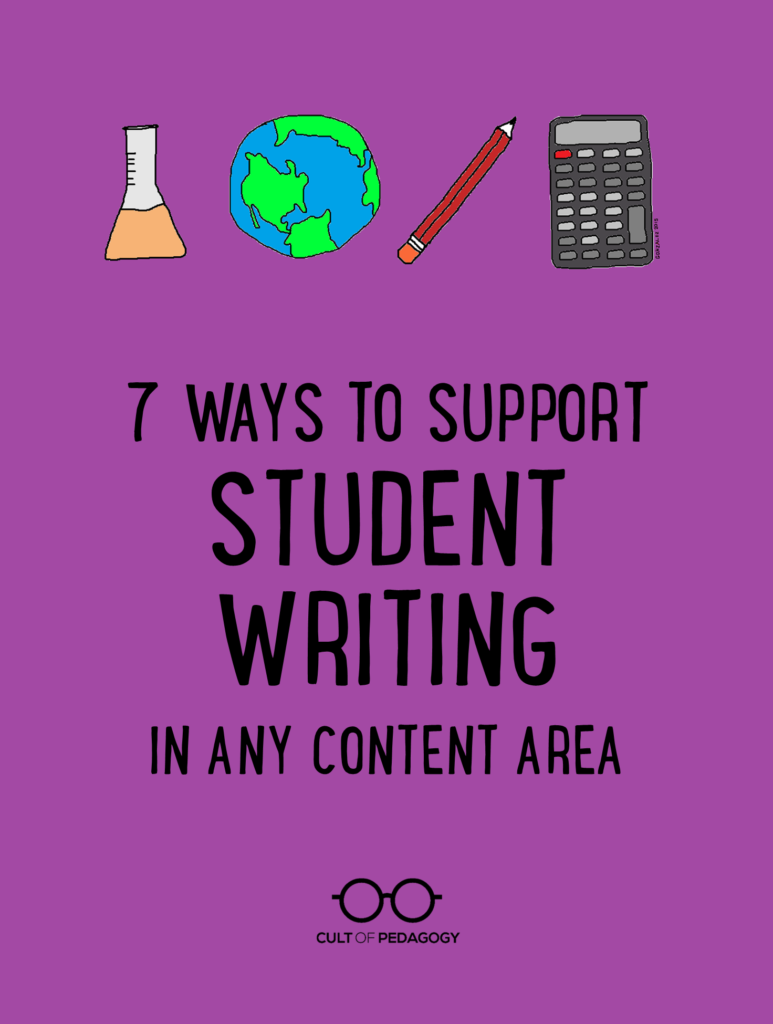
Listen to this post as a podcast (transcript):
More teachers are being asked to support student literacy in all content areas. For those trained in English language arts, this isn’t a big deal. But if you have spent your career learning best practices in science, social studies, physical education, music, math, or one of many other content areas, the idea of “teaching” students how to write on top of covering your own content may seem impossible.
Good news: It’s not all that complicated, and it doesn’t have to be time-consuming, either. You don’t need an English degree to get really good at helping students build writing proficiency in your content area. In this podcast episode, you’ll learn seven easy strategies (plus one bonus tip) to support student writing skills without having to stop teaching your content.
You can get this information by reading the cheat sheet below, listening to the 28-minute podcast, or reading the full transcript.
Then tell me what you think in the comments section below. Have you used some of these strategies yourself? Would you add any others? What questions do you have about implementation? These strategies are simple, but they take some practice: Let’s work together to help our students become strong, confident writers, no matter whose classroom they’re in. ♦
Join my mailing list and never miss another post. You’ll get weekly tips, tools, and inspiration — in quick, bite-sized packages — all geared toward making your teaching more effective and joyful. To thank you, I’ll send you a free copy of my new e-booklet, 20 Ways to Cut Your Grading Time in Half. I look forward to getting to know you better!






When I was teaching, the most I was told was to consider how I might add more writing in my class. I appreciate that these strategies show me how to do it well, or at least better. Thank you!
Hi Toni — that’s kind of what I suspected! Thanks for confirming it for me. Let me know which of these make the biggest difference for you!
These strategies given are a really interesting and engaging way to provide my students an various opportunities to write, and in the end write better. I am excited to put some these strategies learned to work in my own classroom.
Just listening to all of the steps seems like so much, but when I think back to my HS days, this is pretty much what we did from start to finish. (Minus any graphic organizers). I am a HS business teacher, so I do touch upon some of these steps, but have limited time to do so. I have demonstrated the importance of proofreading and how reading your own writing out loud can help find mistakes or even poorly worded sentences. I also always allow students to make corrections and resubmit for a higher score. Two things I never would have done before, but would like to try are grading samples with them and have an ELA teacher compare with my grading.
Yes, I use all of these steps plus peer editing before I correct, and also asking why something is incorrect rather than showing.
I smiled when I read the support tips. It does seems like a common sense reflection during any novice teacher’s experience. Reflecting on your practices, being able to be open minded and quickly test out your solutions is probably the most important skill a teacher could have.
Great tips. Love your quick and easy posts. So helpful for teachers.
One thing we are trying here in Nova Scotia where I teach is integrating the curriculum, so all subject areas are under the math or language arts umbrella. That means learning math and language arts in the context of the other subjects. So far it has been piloted in the K-3 classes. Next year, we expect it to be expanded to include the 4-6. It’s too early to tell how it’s working, but I like it as a concept.
Excellent podcast!
Hi, Jennifer.
THANK YOU for writing this post. These are very practical suggestions, and they are easy to implement. I’ve linked to it in my own blog about writing strategies. I particularly like #4) Write in class. I use a strategy called “Quick Writes” to foster daily writing .
Quick Writes are informal, daily mini-tasks that ask students to produce a reflection or a response to something. Like your other 7 strategies, it can be used across various content to help students 1) pause to reflect on what they have learned through writing 2) develop writing fluency because of the frequency of the writing tasks.
QWs also benefit students because it provides quick feedback on students’ level of understanding or reveal their gaps. Here’s the link to a blog post I wrote about implementing Quick Writes and research behind its effectiveness.
http://wp.me/p7NKW2-6u
Thank you again for your very practical advice!!!!
I’ve been a classroom h.s. English teacher for 30 years and have just started working as a writing interventionist. I use most of these techniques, and have found them super helpful: the read aloud rule is one nearly every student kicks against, but we end up laughing together as the student ends up reading s/t and looking at me to ask, “What did I mean when I wrote THAT?” The mirroring process is crucial, and developing that sense is hard to get in this constantly-distracted world. Great tips. I plan to share them with the Science team I work with! (A lot of these tips also work brilliantly with standards-based learning, which we’re three years into. Huge fan of that, too.)
Hi Jennifer. I like the tips. Many of the strategies around improving grammatical accuracy, sense, word choices etc. in student writing often produce little difference in student work, which can be a great source of frustration to so many teachers. However, I think modelling can have a big impact, especially showing students how to edit and proof read. Talking aloud your thoughts can be a powerful way of offering insight into good practices that students need to learn. It is something I need to do more regularly.
Sometimes it’s the simplest things that make the biggest impact. I’m glad you found these helpful, James!
I’m trying to encourage development of a WAC program at my college and this gives me some great talking points with my colleagues. Thank you.
A good list. I would add writing for multiple purposes and audiences. I think essay writing is oversold as the only way students should be able to write. Not all students students are going to college. What do our students who are going into trades need to be able to communicate?
Great practical suggestions! I’m a firm believer in writing across content areas since writing is a skill that will be used throughout one’s life. As a science teacher, I like to use magazine periodicals with my 5th graders, reading current science news and constructing written responses to them. Great for opinion essays, reflections, and summaries, just to name a few!
I totally agree with what Rita states. I teach reading and writing in both of my classes, and I am a firm believer that if a student or students struggle with reading and comprehension, then they usually struggle greatly with their writing too. Most of these suggested strategies seem common sense yet are fully engaging students to improve.
Thank you for this Jennifer! I love that you present this multi-modal! As the reading teacher on my team, I love how you’ve outlined how to do this; something that appeals to all contents. My struggle is to convince some colleagues to include more reading and writing. Wondering if you have any ideas.
Hi! Something I’ve come to realize is that people become intrigued and most inspired just seeing their colleagues doing some really neat things. I also think it’s important for people to not feel judged about what they’re currently doing. Creating an open dialogue and just sharing research-based practices might be enough. If you haven’t already, check out Jenn’s Content Area Literacy board on Pinterest. There are lots and lots of meaningful ways to support literacy in content areas. Perhaps perusing through here together can spark some ideas.
Thanks Debbie…love pinterest.
While I’ve always written with my students, I think I now see the benefit of offering contemporary writers’ work as an additional way to help my students see the need and benefit of writing in the real world. This will help me offset some of the notions that writing only takes place in the classroom.
For some of my more “challenged” students – I think the sentence stems will really help them, particularly with key portions of a standard essay structure. Many have a terrible time just getting started. While I’ve always preached the “perfect is the enemy of good” philosophy, I still have many students just stuck, starring at the screen.
While I already have them grade their own work with the rubric and have them read me some of their weaker sentence structure,
While I’ve already adjusted my planning to include more in-class writing and conferencing – I’m really relieved to see that it is a promoted part of pedagogy. I’ve always found real-time feedback to be more helpful for these students, but I’ve sometimes worried that I may be “helping” too much. While prewriting and revising are working for the most part – this stage of drafting is where my at-risk kids need the most work, and having it happen with me there is really important.
Grading with them will also be a great final review prior to “publishing” – I’ve had this as part of my process, but Gonzalez’s strategy seems to focus on having them be more honest and critical of their work. I’ve had a problem in the past of the most challenged writers be the least self-critical.
Could you please direct me to the reading tips across contents mentioned in this episode? Thanks.
These are very practical suggestions. I like the idea of writing with students in the class, as well as reading out loud.
The main thing is to create a healthy atmosphere in the classroom, without condemnation and fear.
The post is quite old, but the advice is still relevant.
By the way, how about using additional programs to correct grammar and punctuation? They’re quite popular now. I’d like to hear your opinion.
I really like #6, I think it’s a great way to incorporate #s 1-3, as you can use a variety of examples (from poor to excellent) while also encouraging students to strive for better writing.
These are all great strategies. My nursing course (CNA) is geared around the “doing” as my students are learning how to competently perform various skills needed in caring for patients.
I’m really late for the party! I would reinforce the idea of rewriting not only as a great practice for learning gains but also as a necessary and expected element of the recursive nature of the writing process. While we often have linear models of writing processes, the muddy reality of writing means we’re constantly going back and engaging in revision, even after publication.
I really appreciate your podcast being attached to the article. After a long evening of grad classes and reading articles, it’s nice to switch up the delivery.
My class discussion response:
“7 Easy Ways to Support Student Writing in Any Content Area” was a wonderful explanation of ways to support students writing as I teach art. I love that the author gave a thorough summary of the writing process. It immediately made me think about the creative process that many people are unaware of. I look forward to sharing this article and podcast episode with peers in my building. I was pleasantly surprised that I already do several of the things on the list. I need to find a way to do numbers 1, 3 &7. “
Thanks for sharing. Jenn will be glad to know that the episode and the post were helpful for you!